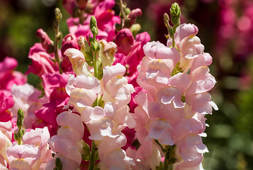|
Ozark Green Thumb BCMG Monthly e-Newsletter |
|
|
 Snapdragons have come into their own for summertime bloom thanks to the efforts of modern day plant breeders.Summertime blooms are important in any flower garden, but heat and humidity often cause flowers to falter and then fail. Not so with Angelonia, or summer snapdragon. It thrives in summertime heat and humidity because it belongs to a group of tropical species found from Brazil to Mexico. Angelonia has gone from obscurity a decade ago to one of the favorites for summertime gardeners. Angelonia angustifolia is a member of the snapdragon family native to Mexico, Cuba and parts of the West Indies. It’s an herbaceous annual in temperate gardens, but in warm places it persists as a perennial. In tropical regions, it can become a sub-shrub. It grows to about 2 feet tall and 18 inches wide in a sprawling mound. Though it has a sprawling habit, its branches are strong, and it never needs staking. The 3-inch long leaves are bright green, simple and willow like. Flowers appear singly in terminal leafy spikes during the summer. Individual flowers are in shades of pink, blue or white and are about an inch across. The throat is open, with the five petals reflexed backwards just a bit. The wild species is more two-lipped as found in most members of the scroph family, but plant breeders have selected forms with more open flowers. Angelonia shows no photoperiod response, but is temperature sensitive. It only blooms well when average temperatures are above 75 degrees Fahrenheit. Angelonia is one of the “new” flowers that appeared, really reappeared, on the horticultural scene during the mid 1990s. It was first grown in the late 19th century but never made its way out of greenhouse conservatories. With the new plant revival, it began to be offered as a patio plant and breeders began developing better garden forms. Modern hybrids involve A. angustifolia and A. integerrima and old cultivars such as Pacific Blue and Alba, a 100-year-old white clone. The Ball people introduced the AngelMist series in 1998; the AngelFace series from Proven Winner appeared in about 2005. The new hybrids are more robust growers than the wild species and display the flowers in a more open fashion. Though seeds are occasionally offered, most plants are grown from cuttings. Angelonias should be planted in sunny locations in a well-drained soil amended with organic matter. It’s not a heavy feeder but benefits from occasional fertilization, especially if blooming has been heavy. Though most commonly seen in southern gardens, Angelonia has done well throughout the country. It’s reliably winter hardy only in zone 10. It makes a good cut flower and will last for more than a week in a vase. Cutting encourages more blooms later in the season. Some gardeners recommend shearing plants back in midsummer to encourage a late season flush of blooms. It’s well suited for use in the mixed border or for patio planters. Once established, Angelonia has great drought tolerance, but we’re talking lantana kind of drought tolerance, not cactus drought tolerance. By: Gerald Klingaman, retired
Extension Horticulturist - Ornamentals Extension News - August 15, 2008
0 Comments
Leave a Reply. |
Archives
April 2022
|
|
